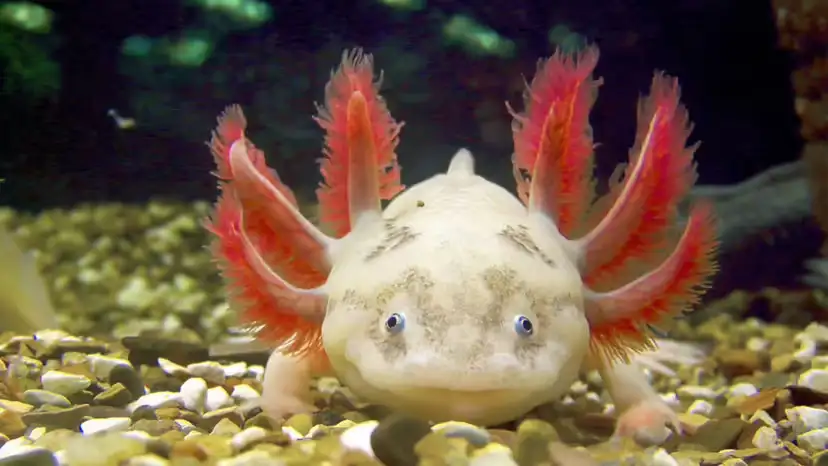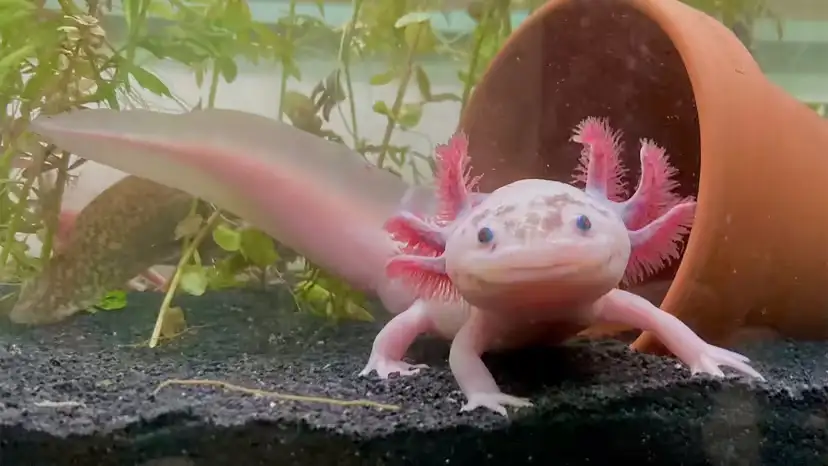The axolotl (Ambystoma mexicanum) has fascinated humans for centuries—not only because of its unusual appearance, but also because of the mythology, biology, and scientific promise surrounding it.
According to Aztec legend, the god Xolotl transformed himself into the first axolotl to escape capture, hiding in the ancient lake system where Mexico City now stands.
Today, this extraordinary amphibian continues to captivate the world, not as a mythical creature, but as one of the most unique species in evolutionary biology and conservation science.

The axolotl, a threatened species, is known as a "walking fish" but is actually an amphibian. Given that picture, you can see why they're so popular in the pet trade, too.
Axolotls are fully aquatic salamanders native to Lake Xochimilco, a shrinking wetland ecosystem located in southern Mexico City. While they were once abundant in the lakes and canals of the Valley of Mexico, Xochimilco is now the last place where truly wild axolotls remain.
Although sometimes called “Mexican walking fish,” axolotls aren’t fish at all—they are amphibians that never leave the water and retain larval traits throughout their entire lives.
Wild axolotls typically exhibit dark brown or black coloring with speckles, helping them blend into muddy lake bottoms.
However, captive axolotls often appear in:
leucistic (pale pink with black eyes)
albino
golden
melanoid (solid black)
These colors exist due to selective breeding in aquariums and laboratories.
Axolotls keep features that most amphibians lose after metamorphosis:
Feathery external gills that branch like delicate coral
A wide, rounded head with a “smiling” appearance
Soft, translucent skin
Webbed feet designed for underwater movement
A long, finned tail for efficient swimming
Because they never transition into a terrestrial adult salamander, they move through the water like a large tadpole rather than a walking amphibian.
Scientists believe axolotls evolved neoteny because they developed in an environment that was stable year-round. Unlike other salamanders that must metamorphose to survive dry seasons, axolotls lived in:
permanent, cool water
habitats with few aquatic predators
nutrient-rich wetlands
With no ecological need to change form, evolution favored individuals that remained juvenile, conserving energy and thriving underwater.
A wild axolotl typically lives 5–6 years, while a well-kept captive axolotl may live up to 15 years.
Sexual maturity is reached at about one year old.
Males locate females using pheromones.
Courtship includes a tail-shaking dance.
Females deposit hundreds of eggs on plants and rocks.
There is no parental care whatsoever.
Newly hatched larvae must hunt microscopic prey immediately, and it’s not uncommon for them to nibble on siblings—regeneration ensures such injuries are temporary.

An axolotl, such as this speckled leucistic axolotl, can live very happily in captivity for as long as 15 years, but for only about five or six years in the wild.
Despite their gentle appearance, axolotls are stealthy carnivores.
worms
insect larvae
mollusks
small fish
crustaceans
Their suction-feeding method allows them to quickly draw prey into the mouth. Because they never leave the water, gills remain their primary oxygen source, although lungs also function if needed.
Axolotls are legendary for their regenerative ability, which extends far beyond simple tail regrowth.
They can regenerate:
limbs
spinal cord
heart tissue
parts of the brain
eyes
nerves and cartilage
They do so without scarring, a trait unmatched in vertebrates.
Axolotls are crucial for research in:
stem cells
developmental biology
scar-free wound healing
organ regeneration
Researchers hope these mechanisms may one day be applied to human medicine.
Axolotls became one of the earliest and most important laboratory animals in Europe, with self-sustaining colonies established as early as the 19th century.
Despite their regenerative “superpowers,” wild axolotls cannot withstand modern environmental pressures.
Pollution from Mexico City’s wastewater
Invasive species (tilapia, carp) that eat eggs and compete for food
Urban expansion destroying wetlands
Agricultural runoff
Habitat fragmentation
Lake Xochimilco is now only a fraction of its original size, and water quality continues to decline.
As a result, axolotls are classified as Critically Endangered (CR) by the IUCN.
Mexican conservationists, biologists, and local communities are implementing multiple strategies to save the species.
Restoring canals with aquatic plants
Building chinampas (traditional floating gardens) to filter water
Controlling invasive fish species
Creating refuges where axolotls can breed safely
Running captive breeding programs
Engaging ecotourism to fund conservation
Centuries ago, Aztec chinampa agriculture created ideal conditions for axolotls. Now, modern conservationists are reviving the ancient technique to rebuild habitat stability.
While wild numbers are collapsing, captive axolotl populations are thriving.
They are among the most widely bred amphibians on the planet, with millions living in laboratories and homes.
Some regions ban axolotls as pets—check local laws.
They need a fully aquatic tank: at least 15–20 gallons.
Never handle them; their skin is delicate.
Never house them with fish or other axolotls—fights are common.
Cool, clean water and a low-flow environment are essential.
Captive axolotls are relatively hardy, but responsible owners must remember that this is a critically endangered species, and ethical care is essential.
The axolotl genome is one of the largest ever sequenced—second only to that of the lungfish.
Its immense genetic complexity may hold answers to some of biology’s greatest mysteries.
animal tags: Axolotls
We created this article in conjunction with AI technology, then made sure it was fact-checked and edited by a Animals Top editor.